| Listing 1 - 10 of 12 | << page >> |
Sort by
|
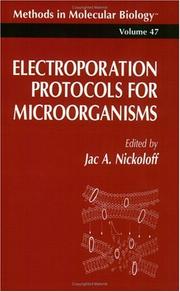
ISBN: 0896033104 9786610836567 1280836563 1592595340 Year: 1995 Publisher: Totowa, NJ : Humana Press : Imprint: Humana,
Abstract | Keywords | Export | Availability | Bookmark
 Loading...
Loading...Choose an application
- Reference Manager
- EndNote
- RefWorks (Direct export to RefWorks)
Electroporation is one of the most widespread techniques used in modem molecular genetics. It is most commonly used to introduce DNA into cells for investigations of gene structure and function, and in this regard, electroporation is both highly versatile, being effective with nearly all species and cell types, and highly efficient. For many cell types, electroporation is either the most efficient or the only means known to effect gene transfer. However, exposure of cells to brief, hi- intensity electric fields has found broad application in other aspects of biological research, and is now routinely used to introduce other types of biological and analytic molecules into cells, to induce cell-cell fusion, and to transfer DNA directly between different species. The first seven chapters of Electroporation Protocols for Micro organisms describe the underlying theory of electroporation, the com mercially available instrumentation, and a number of specialized electroporation applications, such as cDNA library construction and interspecies DNA electrotransfer. Each of the remaining chapters pre sents a well developed method for electrotransformation of a particular bacterial, fungal, or protist species. These chapters also serve to intro duce those new to the field the important research questions that are currently being addressed with particular organisms, highlighting both the major advantages and limitations of each species as a model organ ism, and explaining the roles that electroporation has played in the development of the molecular genetic systems currently in use.
Electroporation. --- Microbial genetics --- Methodology. --- Microorganisms --- Genetics --- Microbiology --- Bioelectrochemistry --- Cytology --- Technique --- Cytology. --- Cell Biology. --- Cell biology --- Cellular biology --- Biology --- Cells --- Cytologists
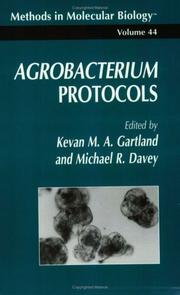
ISBN: 0896033023 9786610836536 1280836539 1592595316 1489927999 9780896033023 Year: 1995 Volume: 44 Publisher: Totowa, NJ : Humana Press : Imprint: Humana,
Abstract | Keywords | Export | Availability | Bookmark
 Loading...
Loading...Choose an application
- Reference Manager
- EndNote
- RefWorks (Direct export to RefWorks)
Agrobacterium Protocols offers beginning and experienced researchers the most comprehensive collection of step-by-step protocols for the genetic manipulation of plants using Agrobacterium. The topics range from the maintenance of bacterial culture collections to aspects of the metabolism and physiology of transformed tissues and transgenic plants. Drawing on the work of leading scientists from laboratories around the world, Agrobacterium Protocols provides a wealth of techniques for introducing specific DNA sequences into target plant species and discusses the environmental implications of genetically engineered plants. Its detailed procedures will facilitate rapid transfer of advanced techniques to other laboratories and their exploitation in fundamental and applied plant biology.
Agricultural biotechnology --- Agrobacterium --- Agricultural biotechnology. --- Agrobacterium. --- Agro-biotechnology --- Biotechnology --- Polymonas --- Rhizobiaceae --- Cytology. --- Cell Biology. --- Cell biology --- Cellular biology --- Biology --- Cells --- Cytologists
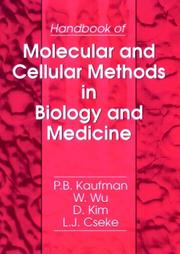
ISBN: 0849325110 Year: 1995 Publisher: Boca Raton CRC
Abstract | Keywords | Export | Availability | Bookmark
 Loading...
Loading...Choose an application
- Reference Manager
- EndNote
- RefWorks (Direct export to RefWorks)
Histology. Cytology --- Molecular biology --- Analytical biochemistry --- Cytology --- -Molecular biology --- -Molecular biochemistry --- Molecular biophysics --- Biochemistry --- Biophysics --- Biomolecules --- Systems biology --- Cell biology --- Cellular biology --- Biology --- Cells --- Cytologists --- Laboratory manuals --- Laboratory manuals. --- -Laboratory manuals
Periodical
ISSN: 09486143 1432119X Year: 1995 Publisher: Heidelberg : Springer-Verlag
Abstract | Keywords | Export | Availability | Bookmark
 Loading...
Loading...Choose an application
- Reference Manager
- EndNote
- RefWorks (Direct export to RefWorks)
Histochemistry and Cell Biology is devoted to the field of molecular histology and cell biology, publishing original articles dealing with the localization and identification of molecular components, metabolic activities and cell biological aspects of cells and tissues. Coverage extends to the development, application, and/or evaluation of methods and probes that can be used in the entire area of histochemistry and cell biology.
Histology. Cytology --- Chemistry --- Histocytochemistry --- Cytology --- Histochemistry --- Cytologie --- Histochimie --- periodicals --- Periodicals --- Périodiques --- Cell Biology. --- Histocytochemistry. --- Cytology. --- Histochemistry. --- Biochemistry --- Cellular Biology --- Biologies, Cell --- Biologies, Cellular --- Biology, Cell --- Biology, Cellular --- Cell Biologies --- Cellular Biologies --- Cytochemistry --- Histology --- Immunology --- General and Others --- Health Sciences --- Life Sciences --- Biology --- Chemistry. --- General and Others. --- Health Sciences. --- Life Sciences. --- Histology. --- Cell Biology --- periodicals. --- Périodiques --- EBSCOASP-E EJBIOMO EJMEDEC EPUB-ALPHA-H EPUB-PER-FT MDBIOCHE MDCYTOLO MDHISTOL SPRINGER-E --- Cell biology --- Cellular biology --- Cells --- Cytologists --- Cytologie.
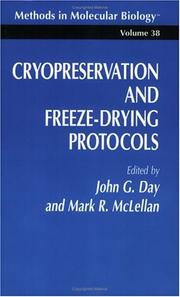
ISBN: 9780896032965 0896032965 9781592595259 9786610836482 1280836482 1592595251 1489940898 Year: 1995 Publisher: Totowa, NJ : Humana Press : Imprint: Humana,
Abstract | Keywords | Export | Availability | Bookmark
 Loading...
Loading...Choose an application
- Reference Manager
- EndNote
- RefWorks (Direct export to RefWorks)
The storage of biological material for regular or future use is a fundamental requirement in many biological and medical sciences. Cryopreservation and freeze-drying are the preferred techniques for achieving long-term storage, and have been applied to a diverse range of biological materials. Though the basis for many methodologies is common, laboratories frequently lack expertise with the correct storage procedures, so that many apply outdated or inappropriate protocols for storing their samples or cultures. Cryopreservation and Freeze-Drying Protocols is a compilation of the many and varied methodologies that have been developed in expert laboratories. The protocols are reproducible, robust, and in most instances have been transferred quite successfully to other laboratories. Our intended readers are those proposing to establish or improve biostorage systems in their own laboratories or units, whether concerned with culture collections, animal husbandry, aquaculture, or human fertilization programs. Because the emphasis of Cryopreservation and Freeze-Drying Protocols is on methodology, it is our intention to provide readers with the tools to make practical progress without reference to other sources. Each chapter deals with an organelle, cell, or tissue type: a short int- duction on the status of its biostorage development is followed by a detailed description of the materials required and a methodological p- tocol to be followed, with explanatory notes. This is very much a first edition; we hope and trust that future editions will contain cryopreservation and freeze-drying protocols for ceils, tissues, and organs that are at present still recalcitrant to succe- ful preservation.
Cryopreservation of organs, tissues, etc. --- Freeze-drying --- Cryopreservation. --- Cryoprotective Agents. --- Freeze Drying. --- Methodology. --- Cryopreservation of organs, tissues, etc --- Freeze Drying --- Cryopreservation --- Tissue Preservation --- Preservation, Biological --- Histocytological Preparation Techniques --- Specimen Handling --- Investigative Techniques --- Laboratory Techniques and Procedures --- Analytical, Diagnostic and Therapeutic Techniques and Equipment --- Histological Techniques --- Cytological Techniques --- Clinical Laboratory Techniques --- Diagnosis --- Biology - General --- Cytology --- Biology --- Health & Biological Sciences --- Methodology --- Life sciences. --- Cell biology. --- Life Sciences. --- Cell Biology. --- Cell biology --- Cellular biology --- Cells --- Cytologists --- Biosciences --- Sciences, Life --- Science --- Cytology.
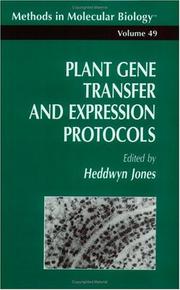
ISBN: 089603321X 9786610836581 128083658X 1592595367 1489940596 9780896033214 Year: 1995 Volume: 49 Publisher: Totowa, NJ : Humana Press : Imprint: Humana,
Abstract | Keywords | Export | Availability | Bookmark
 Loading...
Loading...Choose an application
- Reference Manager
- EndNote
- RefWorks (Direct export to RefWorks)
The development of recombinant DNA technology and methods for transferring recombinant genes into plants has brought about significant advances in plant science. First, it has allowed investigation, using reporter genes, into the transcriptional regulation of plant genes—a key to the under standing of the biochemical basis of growth and development in plants. Second, gene transfer technology has facilitated the molecular cloning, by tagging genomic sequences, of important genes (e. g. , homeotic genes) whose gene products control the normal pattern of growth and differentia tion of plants. Third, overproducing foreign or endogenous proteins in plants can often lead to a better understanding of biochemical and physiological processes. Fourth, gene transfer technology has allowed the improvement of plant agricultural productivity. For example, plants have been engineered with improved viral resistance or the ability to withstand herbicide attack, therefore allowing a more effective use of herbicides to kill weeds. Fifth, there have been recent successes that demonstrate the potential use of plants as biotechnological chemical factories. For example, it is possible to use plants in the production of human antibodies and antigens of medical importance. It has been demonstrated recently that plants can be engineered to produce modified oils and even plastics! This paves the way to redirect agriculture from the production of surplus foods to the production of bio technological products of industrial importance.
Plant genetic engineering --- Plant gene expression --- Crops --- Laboratory manuals --- Genetic engineering --- Laboratory manuals. --- Gene expression --- Plant molecular genetics --- Agricultural crops --- Crop plants --- Farm crops --- Industrial crops --- Farm produce --- Plants, Cultivated --- Agronomy --- Crop science --- Plant products --- Plants --- Plant biotechnology --- Transgenic plants --- Cytology. --- Cell Biology. --- Cell biology --- Cellular biology --- Biology --- Cells --- Cytologists --- Plant genetic engineering - Laboratory manuals --- Plant gene expression - Laboratory manuals --- Crops - Genetic engineering - Laboratory manuals
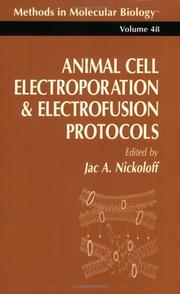
ISBN: 089603304X 9786610836574 1280836571 1592595359 1489940618 Year: 1995 Publisher: Totowa, NJ : Humana Press : Imprint: Humana,
Abstract | Keywords | Export | Availability | Bookmark
 Loading...
Loading...Choose an application
- Reference Manager
- EndNote
- RefWorks (Direct export to RefWorks)
The ability to introduce macromolecules into animal cells, includ ing DNA, RNA, proteins, and other bioactive compounds has facili tated a broad range of biological studies, from biochemistry and biophysics to molecular biology, cell biology, and whole animal stud ies. Gene transfer technology in particular will continue to play an essential role in studies aimed at improving our understanding of the relationships between the gene structure and function, and it has impor tant practical applications in both biotechnology and biomedicine, as evidenced by the current intense interest in gene therapy. Although DNA and other macromolecules may be introduced into cells by a variety of methods, including chemical treatments and microinjection, el- troporation has proven to be simpler to perform, more efficient, and effective with a wider variety of cell types than other techniques. The early and broad success of electric field-mediated DNA transfer soon prompted researchers to investigate electroporation for transferring other types of molecules into cells, including RNA, enzymes, antibodies, and analytic dyes. Animal Cell Electroporation and Electrofusion Protocols begins with three chapters that describe the theoretical and practical aspects of electroporation, including a review of the commercially available instrumentation. These introductory chapters will be of particular inter est to those new to electric field technologies and to those developing protocols for as yet untested species or cell types. Nineteen chapters follow that present well-tested protocols for electroporation of proteins and DNA into insect, fish, and mammalian cells.
Animal cell biotechnology. --- Electrofusion. --- Electronic books. -- local. --- Electroporation. --- Electroporation --- Electrofusion --- Animal cell biotechnology --- Electrochemical Techniques --- Clinical Laboratory Techniques --- Cell Physiological Processes --- Investigative Techniques --- Cytological Techniques --- Cell Fusion --- Genetic Techniques --- Cell Physiological Phenomena --- Analytical, Diagnostic and Therapeutic Techniques and Equipment --- Phenomena and Processes --- Biology --- Cytology --- Health & Biological Sciences --- Animal cells in biotechnology --- Animal biotechnology --- Bioelectrochemistry --- Membrane fusion --- Technique --- Cytology. --- Animal genetics. --- Cell Biology. --- Animal Genetics and Genomics. --- Genetics --- Cell biology --- Cellular biology --- Cells --- Cytologists
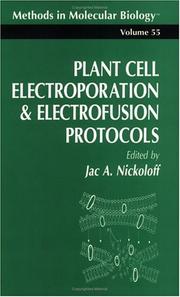
ISBN: 0896033287 9786610836642 1280836644 1592595421 1489940804 Year: 1995 Publisher: Totowa, NJ : Humana Press : Imprint: Humana,
Abstract | Keywords | Export | Availability | Bookmark
 Loading...
Loading...Choose an application
- Reference Manager
- EndNote
- RefWorks (Direct export to RefWorks)
Gene transfer is an essential technology for improving our under standing of gene structure and function. Although there are many meth ods by which DNA may be introduced into cells—including heat and chemical treatments, and microinjection—electroporation has been found to be the most versatile gene transfer technique. Electroporation is effective with a wide variety of cell types, including those that are difficult to transform by other means. For many cell types, electroporation is either the most efficient or the only means known to effect gene transfer. The early and broad success of electric field-medi ated DNA transfer soon prompted researchers to investigate electroporation for transferring other types of molecules into cells, in cluding RNA, enzymes, antibodies, and analytic dyes. The first section of Plant Cell Electroporation and Electrofusion Protocols includes two chapters that serve as a guide to theoretical and practical aspects of electroporation, and will be of particular interest to those developing protocols for as yet untested species or cell types, and a third chapter that describes commercially available electroporation instruments. The remaining chapters describe well-tested protocols for DNA electrotransfection, electroporation of other biomolecules, or cell electrofusion. These chapters also include brief discussions of alterna tives to electric field-based methods, citing the advantages and limita tions of the various methods for achieving specific goals.
Plant genetic engineering --- Plant genetic transformation --- Crops --- Electroporation --- Electrofusion --- Cell Fusion --- Plants --- Genetic Techniques --- Cytological Techniques --- Cell Physiological Processes --- Clinical Laboratory Techniques --- Electrochemical Techniques --- Investigative Techniques --- Eukaryota --- Cell Physiological Phenomena --- Organisms --- Analytical, Diagnostic and Therapeutic Techniques and Equipment --- Phenomena and Processes --- Plant Ecology --- Botany --- Earth & Environmental Sciences --- Laboratory manuals --- Genetic engineering --- Laboratory manuals. --- Bioelectrochemistry --- Cytology --- Membrane fusion --- Agricultural crops --- Crop plants --- Farm crops --- Industrial crops --- Farm produce --- Plants, Cultivated --- Agronomy --- Crop science --- Plant products --- Plant transformation --- Genetic transformation --- Plant biotechnology --- Transgenic plants --- Technique --- Cytology. --- Cell Biology. --- Cell biology --- Cellular biology --- Biology --- Cells --- Cytologists
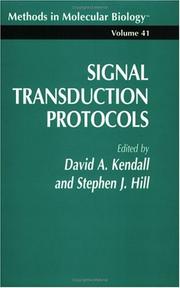
ISBN: 0896032981 9786610836505 1280836504 1592595286 9780896032989 Year: 1995 Volume: 41 Publisher: Totowa, NJ : Humana Press : Imprint: Humana,
Abstract | Keywords | Export | Availability | Bookmark
 Loading...
Loading...Choose an application
- Reference Manager
- EndNote
- RefWorks (Direct export to RefWorks)
As our understanding of the biological sciences expands, the boundaries between traditional disciplines tend to blur at the edges. Physiologists and pharmacologists, for instance, now need to embrace techniques that until recently were the strict preserves of biochemists and molecular biologists. However, the acquisition of new technologies can be a time-consuming and frustrating business, and unless an expert is on hand to give instruction, precious hours can be spent poring over half-described Methods sections with no guarantee of eventual success. The aim of Signal Transduction Protocols has been to get experts with "hands-on" experience in particular techniques to give detailed accounts of experimental protocols in a recipe-type format, which we hope will circumvent the problems of ambiguity often encountered when reading the literature. The techniques described in Signal Transduction Protocols are those that we think will be most useful in addressing questions in the area of receptor-mediated cell signaling, with particular regard to those receptors that are part of the G-protein-linked superfamily. To keep it to a manageable size, we have omitted any reference to electrophysiology and have instead concentrated on more biochemical approaches.
Molecular biology --- Cellular signal transduction --- Cell receptors --- G proteins --- Research --- Methodology --- 577.2 --- 547 --- -Cellular signal transduction --- -G proteins --- -#WDIR:vfm2 --- GTP-binding proteins --- GTP regulatory proteins --- Guanine nucleotide-binding proteins --- Guanine nucleotide regulatory proteins --- Membrane proteins --- Cellular information transduction --- Information transduction, Cellular --- Signal transduction, Cellular --- Bioenergetics --- Cellular control mechanisms --- Information theory in biology --- Cell membrane receptors --- Cell surface receptors --- Receptors, Cell --- Binding sites (Biochemistry) --- Cell membranes --- Proteins --- Molecular bases of life. Molecular biology --- Organic chemistry --- -Methodology --- Methodology. --- 547 Organic chemistry --- 577.2 Molecular bases of life. Molecular biology --- #WDIR:vfm2 --- Research&delete& --- Proteids --- Biomolecules --- Polypeptides --- Proteomics --- Cytology. --- Cell Biology. --- Cell biology --- Cellular biology --- Biology --- Cells --- Cytologists --- Cellular signal transduction - Research - Methodology --- Cell receptors - Research - Methodology --- G proteins - Research - Methodology
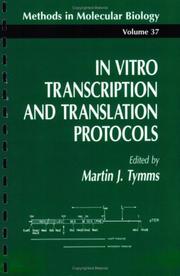
ISBN: 9780896032880 0896032884 9781592595242 9786610836475 1280836474 1592595243 1489940715 Year: 1995 Publisher: Totowa, NJ : Humana Press : Imprint: Humana,
Abstract | Keywords | Export | Availability | Bookmark
 Loading...
Loading...Choose an application
- Reference Manager
- EndNote
- RefWorks (Direct export to RefWorks)
Most laboratories conducting studies that use molecular biology techniques employ in vitro transcription and translation systems as a routine part of their day-to-day research. The commercial availability of purified bacterial RNA polymerase and the availability of robust tra- lation systems has made in vitro systems attractive not only as an alt- native to the in vivo expression of genes, but also as good model systems for studying specific aspects of transcription and translation. Although fairly efficient eukaryotic translation systems have been established for a number of years, reconstitution of transcription in vitro has proved to be more difficult. Recent improvements in fractionation techniques and the cloning of proteins involved in transcription have made this a fast moving area of research. Considerable progress has also been made in recent years in developing in vitro systems to study transcription and translation in chloroplasts and mitochondria, together with systems for the study of protein import. In Vitro Transcription and Translation Protocols provides many detailed experimental procedures for prokaryotic transcription and translation systems, together with protocols for many key techniques used in the analysis of eukaryotic transcription. In keeping with the successful format of preceding volumes of the Methods in Molecular Biology series, step-by-step instructions are provided, together with extensive notes that cover troubleshooting and special tips considered important.
Protein Biosynthesis --- Transcription, Genetic --- Genetic Techniques --- Molecular Biology --- Molecular genetics --- Genetic transcription --- Genetic translation --- Génétique moléculaire --- Transcription génétique --- Traduction génétique --- Laboratory Manuals --- Laboratory manuals --- Manuels de laboratoire --- Moleuclar genetics --- Peptide Biosynthesis --- Biochemical Processes --- Gene Expression --- Biochemistry --- Genetics --- Investigative Techniques --- Chemical Processes --- Metabolism --- Biology --- Biological Science Disciplines --- Analytical, Diagnostic and Therapeutic Techniques and Equipment --- Genetic Processes --- Chemistry --- Biochemical Phenomena --- Chemical Phenomena --- Natural Science Disciplines --- Genetic Phenomena --- Metabolic Phenomena --- Disciplines and Occupations --- Phenomena and Processes --- Health & Biological Sciences --- Laboratory manuals. --- -Genetic transcription --- -Genetic translation --- -577.2 --- 57.088 --- Translation (Genetics) --- Genetic code --- Genetic regulation --- Transcription (Genetics) --- Molecular bases of life. Molecular biology --- Special methods and techniques for studing biological molecules. Separation. Centrifuging. X-ray study. Radioisotope methods --- 57.088 Special methods and techniques for studing biological molecules. Separation. Centrifuging. X-ray study. Radioisotope methods --- 577.2 Molecular bases of life. Molecular biology --- 577.2 --- Life sciences. --- Cell biology. --- Life Sciences. --- Cell Biology. --- Cell biology --- Cellular biology --- Cells --- Cytologists --- Biosciences --- Sciences, Life --- Science --- Cytology.
| Listing 1 - 10 of 12 | << page >> |
Sort by
|

 Search
Search Feedback
Feedback About
About Help
Help News
News